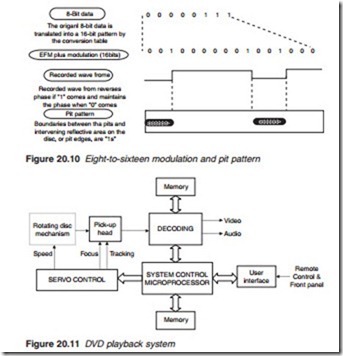Eight-to-sixteen modulation (EFM+)
With NRZI encoding, it is possible to end up with a long stretch stream of zeroes or ones. Such a situation would result in a long stretch of a constant high or low voltage with no transitional edge. Since clock synchronisation depends on the regular occurrence of such a transitional edge, a long absence of such an edge would cause a breakdown of time synchronisa- tion at the player. To avoid this eight-to-sixteen modulation is used.
Eight-to-sixteen (8/16) modulation converts each word of 8 bits (one- byte) of data into a 16-bit code selected from a conversion table. An 8-bit word has 28 = 256 different combinations or words. A 16-bit code on the other hand, has 216 = 65,536 different codes. Out of these 65,536 codes, 256 are, carefully selected to minimise DC energy and reduce frequency. The selected codes are chosen in such a way that in each code at least two or at most ten zeros occur between any groups of ones. For example the 8-bit word 0000011 is converted into the 16-bit code 0010000001001000 as illus- trated in Figure 20.10. The 16-bit code is then further encoded using NRZI resulting in a simple waveform shown which is then translated into two pits and a land. Eight-to-sixteen modulation is normally referred to as EFM+ (eight-to-fourteen Plus) because EFM (eight-to-fourteen) modula- tion) was originally used for modulating a CD audio channel data.
DVD playback system
The pick-up head reads the data on the disc, sector by sector (Figure 20.11). The speed of the disc, the position of the head as well as the beam focus is controlled by the servo control unit, which itself is controlled by the system control (sys con) microprocessor chip. The data from the pick-up head is fed into the decoding unit to re-produce the original audio and
video signals. The process of decoding involves error correction and data de-compression, both of which require the use of random access memory (RAM) store. Memory is also required by the sys con microprocessor to store the necessary processing routines as well as various configura- tions and settings. The user accesses the player’s facilities using a remote control or front panel switches. Signals from these are sent to the micro- processor via the user interface.
